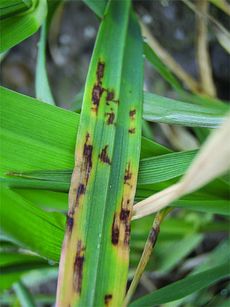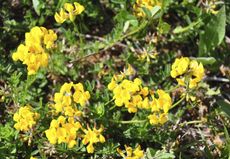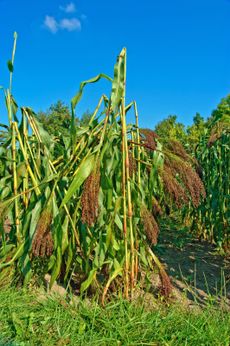Grains
Wheat, barley, oats, rye and other grains are typically grown in agricultural surroundings, but there’s no reason you can’t grow grain plants in your garden. Some types of grains can even be grown indoors on your kitchen counter. Keep in mind, however, that growing conditions vary widely for different grain plants. The following articles will provide information on growing and harvesting grains in the home garden.
Grains
-

Barley Net Blotch Treatment: How To Prevent Net Blotch On Barley Plants
A very common barley issue, called barley net blotch, can be a major cause of frustration and may even result in loss of yields for growers. Luckily, the application of several simple garden practices can help to reduce problems. Learn more in this article.
By Tonya Barnett
-

Crimson Clover Plants – Tips For Growing Crimson Clover As A Cover Crop
Very few nitrogen fixing cover crops are as breathtaking as crimson clover. With their bright crimson red, conical blooms and tall fleecy stems, one might think a field of crimson clover was planted purely for aesthetic appeal. Click here for more information.
By Darcy Larum
-

What Is 6-Row Barley – How To Grow 6-Row Barley For Beer Making
Whether wishing to make their farm more sustainable or hoping to grow barley for its use in beer making, there is no doubt that its growers have mixed opinions regarding how different types of the plant should be used, like 6-row barley plants. Learn more about it here.
By Tonya Barnett
-

What Is 2-Row Barley – Why Grow 2-Row Barley Plants At Home
Although labor intensive, the process of growing grains, such as 2-row malting barley, for use in home brewing is one that can be extremely rewarding. Learn more about growing 2-row barley for beer in this article. Click here for additional information.
By Tonya Barnett
-

What Is Triticale – Learn How To Grow Triticale Cover Crops
Cover crops are not just for farmers. Home gardeners can also use this winter cover to improve soil nutrients, prevent weeds, and stop erosion. Legumes and grains are popular cover crops, and triticale as a cover crop is great too. Learn more about it here.
By Mary Ellen Ellis
-

Why Grow Perennial Legumes – Learn About Planting Perennial Legumes
Most legumes grown in the home garden, including beans and peas, are annual plants, which means they complete a life cycle in a single year. Perennial legumes, on the other hand, are those that live for more than two years. Learn more about these in this article.
By Mary H. Dyer
-

Velvet Bean Information: Learn About Growing Velvet Bean Plants
Velvet beans are very long climbing vines that produce white or purple flowers and deep purple bean pods. They?re popular as medicine, cover crops, and occasionally as food. Learn more about planting and growing velvet beans in this article.
By Liz Baessler
-

What Is Winter Rye Grass: Growing Winter Rye As A Cover Crop
Cover crops are planted to minimize soil erosion, increase beneficial microbiological activity and generally improve soil tilth. Considering growing a cover crop? There are many to choose from but winter rye is a standout. Learn more in this article.
By Amy Grant
-

What Is Living Mulch: How To Use Living Mulch As A Groundcover
Living mulch provides numerous benefits to the garden and soil. What is living mulch? Any plant that is used to cover an area of soil and adds nutrients, enhances soil porosity, decreases weeds and prevents soil erosion, among other attributes. This article will help.
By Bonnie L. Grant
-

Birdsfoot Trefoil Uses: Planting Birdsfoot Trefoil As Cover Crop
If you're looking for a cover crop for difficult soil, the birdsfoot trefoil plant may be just what you need. This article discusses the pros and cons of using birdsfoot trefoil as a cover crop, as well as basic growing techniques. Click here to learn more.
By Jackie Carroll
-
Learn About Oaxacan Green Dent Corn
Hanging onto the old seed varieties is your responsibility, but it also affords you a glimpse into ancient cultures and civilizations. Oaxacan green dent corn is an heirloom variety of corn that traces its roots to a native people from Mexico.
By Bonnie Grant
-

Information On Emmer Wheat Origins
By Liz Baessler
-

How To Harvest Quinoa: Tips For Growing And Harvesting Quinoa
What exactly is the quinoa harvesting process? Is harvesting of quinoa done by hand? Read on to learn more.
By Amy Grant
-

Growing Rice At Home: Learn How To Grow Rice
Rice is one of the oldest and most revered foods on the planet. Rice requires tons of water plus hot, sunny conditions to grow. This makes planting rice impossible in some areas but you can grow your own rice at home, sort of. Click here to learn more.
By Amy Grant
-

Winter Wheat Cover Crops: Growing Winter Wheat At Home
Winter wheat is a member of the Paceae family and is usually planted in the Great Plains region as a cash grain but is also an excellent green manure cover crop. Learn how to grow winter wheat in gardens here.
By Bonnie L. Grant
-

Oat Rust Control: Treating Oats With Crown Rust
Crown rust is the most widespread and damaging disease found in oats. For individual growers, oats with crown rust can result in a total crop loss. Click here to learn more about control and treatment of oat rust.
By Amy Grant
-

Using Broomcorn For Crafts – How To Harvest Broomcorn Plants
Broomcorn produces big, fluffy seed heads that resemble the end of a broom. If you’re feeling crafty and would like to know more about using broomcorn as well as tips on harvesting the plant, click this article to learn more.
By Bonnie L. Grant

